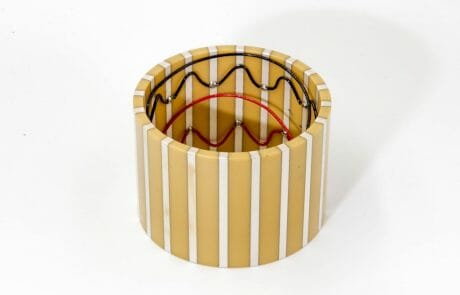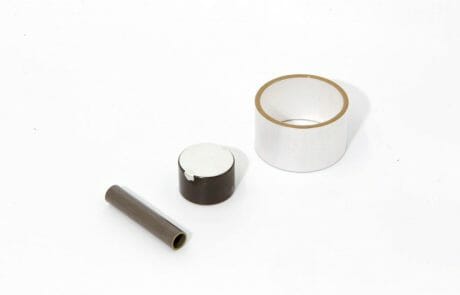What Are Piezoelectric Tubes?
Piezoelectric tubes are thin-walled cylinders lined with electrodes that can achieve axial displacement (changes in length) or radial displacement (changes in diameters). Most piezoelectric tubes are radially polarized, containing one or several separate electrodes on the internal wall and several separate electrodes lining the external wall, depending on the intended application. There are three main configurations of piezoelectric tubes with either plain electrodes, split electrodes, or striped electrodes, which all achieve displacement in vertical, radial, and circumferential directions. The piezo tube will contract or expand radially and axially as soon as a voltage is applied. In piezo tube scanners, lateral deflection of the tube tip is also possible by using striped or segmented outer electrodes to generate axial and XY displacement. The direction of displacement depends on the placement of electrodes along the piezo tube actuator, in conjunction with the direction of polarization and the application of the voltage. One end of the piezoelectric tube is fixed, while the piezo tube body is responsible for deflection. Axial elongation and radial expansions are achievable with piezoelectric tube actuators, sensors, and transducers.
Piezo tubes can be configured with vertically segmented, horizontally segmented, or wrap around electrodes, depending on the desired result of the piezoelectric tube. In general, there are two different manufacturing processes to make the piezo tubes. Piezoelectric tubes with relatively large inner and outer diameters can be casted and achieve necessary tolerances through machining. Piezo tubes with a small inner diameter and/or a large length to diameter ratio has to be extruded.
Capabilities of PZT Ceramic Tubes
Uncover the capabilities of PZT ceramic tubes with Piezo Direct’s dedicated page on Piezo Tube Actuator Cylinders. These tubes, composed of high-quality piezoelectric ceramics, enable precise linear motion and are ideal for applications like valve control, pump systems, and micro-positioning.
Piezoelectric tubes are extremely versatile, with fast response times, high operating frequencies and acceleration, and the ability to operate in rigid environments. Piezo ceramic tubes are compatible with vacuum and cryogenic environments. Piezoelectric tubes have quick response times, high acceleration, and high operating frequencies. Piezo tubes are not typically utilized for force generation, but their diversity and reliability in microscopic applications makes piezo tube elements a great source for accuracy and precision. Piezoelectric tubes are suitable in actuator, sensor, transducer, and ultrasonic applications.
Applications
- Microdosing , nanodosing, and ultrasound equipment
- Inkjet printers
- Fiber optics
- Scanning probe microscopy
- Pressure sensors
- Force and strain sensors
- Level and flow sensors
- Accelerometers
- Hydrophones and sensor technology
- Ultrasonic NDT


PZT ceramic tubes, constructed from Lead Zirconate Titanate material, represent a specialized form of piezoelectric technology with unique applications. These tubes possess the remarkable ability to convert electrical energy into mechanical vibrations and vice versa due to the inherent piezoelectric effect of PZT. This property makes PZT ceramic tubes essential components in various fields such as ultrasonic transducers, sensors, and acoustic devices. Their tubular shape allows for efficient propagation of mechanical waves, enabling precise control over the frequency and intensity of vibrations. PZT ceramic tubes find applications in medical imaging, non-destructive testing, and industrial process control, where their ability to generate and receive ultrasonic signals plays a crucial role. The adaptability of PZT ceramic tubes to different operating frequencies and environmental conditions makes them a versatile choice for industries requiring precise and reliable acoustic performance.
Piezo Direct offers a variety of custom piezoelectric tubes and pzt ceramic tubes. Shape, finish, material, dimensions, and performance levels can all be customized! Piezo Direct’s piezo tube and pzt ceramic tube elements are suitable for numerous applications. Contact us! Piezo Direct is more than happy to work with you to design a custom piezoelectric tube to meet your application requirements.
- Tube Actuators
- Tube Sensors
- Tube Transducers
Tube Piezo Actuators
Detailed Mechanics
Tube piezo actuators are monolithic cylinders lined with electrodes that are able to generate radial or axial displacement. The direction of displacement depends on the placement of electrodes and application of voltage. Piezo tube actuators can generate axial displacement (changes in length) or radial displacement (changes in diameters). Axial elongation or radial expansion are all achievable with piezoelectric tube actuators depending on where and how the electrodes are placed, which direction it is polarized, and how the voltage is applied. Electrodes on the inner and outer surfaces of the piezo tube actuator are responsible for expansion and contraction latitudinally and longitudinally without bending.
Applications
Piezoceramic tube actuators are excellent for high precision nano movement and dosing. In medical applications, piezoelectric tubes are employed in microdosing machines and ultrasound equipment. In some minimally invasive procedures, piezo tube actuators implemented into catheters generate ultrasound waves which increase the permeability of the blood vessel walls, making it easier for medication to penetrate.
One of the most common applications for tube actuators can be seen in scanning probe microscopy that scans surfaces to create topographic images. The thin probe is controlled by a very small piezo tube actuator that can dynamically move the probe in micrometers to expand and contract along the axis (up and down movement) or bend side to side when a current is applied. The resulting displacement of the piezo tube is proportional to the surface qualities and can be converted to measure its properties (see tube piezo transducers).
Pump applications also utilize piezoceramic tube actuators. In inkjet printers, piezoelectric tubes in the ink nozzles release the precise amount of ink needed in picoliters to produce the individual dots of ink that make up printed words. Micro- and nano-dispensing are one of the key applications for piezo tube actuators.
High power piezo tube actuators have also been used as an ultrasonic power/wave generator for the ultrasonic cleaning equipment. Piezo tube actuators are also widely used in high power acoustic applications as ultrasound transmitters. For example, underwater hydrophones and sonar utilize piezo tube actuators as the ultrasonic signal generator.
Tube Piezo Sensors
Detailed Mechanics
Tube piezoelectric sensors directly measure a dynamic force or strain and produce a proportional electrical output that can be read to measure the incoming mechanical input. Piezo sensor tubes are extremely reliable for monitoring mechanical energy as the electrical output generated is proportional to the applied pressure and physical displacement received by the tube. Though not suitable for measuring static pressure, piezoelectric sensors are highly sensitive to minute changes in dynamic environments. Tube piezo sensors are rugged, stable, compact, and able to operate in extreme temperatures and environments. Measurement technology has greatly benefitted from the accuracy, efficiency, and reliability afforded by tube piezoelectric sensors.
Applications
Piezo tube sensors are most commonly utilized in industrial and production applications. Given their ability to immediately detect very small changes, tube piezo sensors are widely used in industrial machinery for monitoring production, assembly, and testing. Production and manufacturing rely on the accuracy of piezoelectric sensors to keep their productivity and reliability levels high. Automotive, construction, and welding applications also utilize tube piezo sensors for inspection purposes. Piezoelectric tube actuators have also been used in industrial non-destructive testing to detect the surface and/or material flaws.
PIn other industrial applications, tube piezo sensors are also used as level sensors and flow sensors for liquids and gas. As fluid fills or passes through a medium, piezoelectric sensors measure the flow rate or liquid pressure levels and produce a proportional readable electrical output.
Tube Piezo Transducers
Detailed Mechanics
Tube shaped piezoelectric transducers can be thought of as a combination of tube piezo actuators and tube piezo sensors. Piezoelectric transducers are capable of receiving an electrical input and producing a mechanical output or receiving a mechanical input and producing an electrical output, depending on the construction of the tube. Often, both piezoelectric effects are needed so that the electrical response produced by the piezo sensor component can be used as the electrical input for the piezo actuator component to make necessary adjustments to the source being measured. Piezoelectric transducer tubes are compatible in cryogenic and extreme environments.
Applications
Piezo tube transducers are commonly found in microscopic applications where accuracy and precision are desired. If a piezoelectric sensor component is added to scanning probe microscopy, the displacement generated from the initial alternating current applied to the piezo tube actuator can be used as the mechanical input needed to produce an electrical output measurement. The physical displacement to the tube piezo transducer is proportional to the surface qualities and can be converted to measure surface properties through a readable electrical output.
Microdosing, microdispensing, and pipetting equipment and machinery also utilize piezoelectric transducer tubes to release and monitor precise volumes and drop sizes. When a voltage is applied, the piezo tube contracts, generating pressure in the nozzle capillary and creating precisely defined droplets. The tube piezoelectric transducers can then monitor the levels dispensed and send an electrical signal to release more droplets as needed.
In ultrasonic applications, tube piezo transducers are commonly used for non-destructive testing and evaluation. Either one or two tube piezo elements will be used to emit ultrasonic frequencies through the medium being measured. The ultrasonic waves are either reflected back to the same piezo transducer or received by other piezo transducer to be measured.
